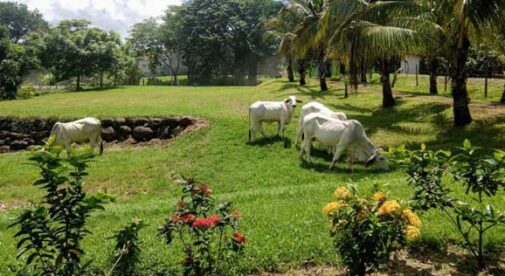Having lived on Panama’s picturesque Pacific Coast, known as the Azuero Peninsula, for a few years now, my husband Dan and I enjoy rural living at its finest. Lush hillsides tumble down to the sparkling ocean, horses and cows graze in nearby fields, and friendly neighbors are all around.
For us, this is paradise.
A leisurely six-hour drive from Panama City, and only 20 minutes from bustling Pedasí and five minutes from bohemian Playa Venao, we live in a prime location.
This dry season, which lasts from December to May, we decided to do some home upgrades. Our home, Casa Blanca del Mar, is approximately 2,200 square feet, including a spacious patio with an attached pool.
Our small plunge pool needed refurbishment, and we finally decided to get a generator to make the occasional power outages seamless. This meant building a shed to house the generator.
Since most construction projects are done during dry season and with construction proceeding at an unprecedented rate here, we were a bit hesitant as to who to hire and how to get these projects done in a timely manner. Basically, it can be difficult to source contractors and materials.
However, after some due diligence and valuable recommendations from our neighbors, we sourced two quality crews—one for the pool and the other for the generator house.
Both crews were led by English-speaking contractors. Many Panamanians have trained and worked in the United States and speak English fluently. Also, Playa Venao is home to a large Israeli population who speak perfect English, Hebrew, and Spanish.
With communication being so important in doing two projects simultaneously, we were happy to have such cosmopolitan crews.
After 10 years of use, our 5,000-gallon plunge pool was old and deteriorating. The Israeli contractor, although very busy, fit us in because, as far as pools go, we were a small project.
He surveyed the job and gave us an approximate quote, indicating that it was difficult to assess exactly what needed to be done until the jack hammering and sanding of the pool began. And, of course, as all renovations go, considerable upgrading of the existing concrete was required.
The pool was professionally reshaped and sealed in preparation for the Diamond Brite application. Diamond Brite, a sealant which gives pools their beautiful blue color, is the preferred pool finish here.

In the meantime, new pool tiles and deck tiles had to be sourced. Luckily, a new pool store in a nearby city stocks quality pool materials and equipment.
The pool took one month to complete, with power and supply chain interruptions, but that included cement wall reconstruction, multiple sealant coatings, tile applications in the pool and on the deck surrounding the pool, and the Diamond Brite finish. Cost: $8,500.
We feel that we probably paid up for the pool, but the results are amazing.

Most importantly, we learned that refinishing a pool is an exacting process that must be done in sequence and on a timeline, so dealing with a professional pays off.
And the professionalism shone through every day. The crew was well organized, knowledgeable, efficient, cheerful and, to our delight, fun. The contractor got right into the mix working shoulder to shoulder with his crew. Working hard in the heat of dry season, the crew always broke out in smiles when we passed around cold beers at the end of the day.
While our pool re-finishing was being carried out on the ocean side of our house, a generator shed was being built at the end of our driveway near the road for easy access to the existing power lines.
Typically, there is a scheduled power outage for power line upgrading and maintenance every Wednesday in our area. Given the Panamanian climate it is common to have power outages due to overheating transformers in the dry deason and to heavy rainfall in green season.
With a whole house generator, everything in the house continues running, including fridges, water pumps, and air conditioners.
Our is generator house is 54 square feet and houses a 14 KW Generac generator. The generator has an automatic on/off switch. When the power grid stops the generator kicks in. When the power returns, the generator kicks off. The generator is powered by 100 lb. propane cylinders that cost $90 a piece. A single tank can run up to 19 hours. The propane tank delivery service comes once or twice a week and can be scheduled by WhatsApp, a vital communication tool in Panama.
Cinder blocks are a common building material for houses and most other structures in Panama. The cinder blocks are interlaced with rebar to strengthen the structure and prevent cracking, and then finished with a thin layer of concrete.
The generator house took two weeks to complete and cost $2,500, including materials and labor. The generator cost was $5,671 and the installation another $1,500.
The construction of our generator shed, which is very solid, was completed by two men, one who had worked in the United States for 25 years before returning to Panama. He and his Panamanian brick layer worked long, hard days, usually starting before 8 a.m. and finishing by 4 p.m. They took care of sourcing all the materials and having them delivered or bringing them in their truck. We really didn’t have to do anything, except deliver a few cold beers at the end of the day!
Through recommendations we found the right people for the job, stayed on-site to address issues as they arose, and Dan consulted with the contractors every step of the way. We feel that we have completed a successful period of home upgrades that we will enjoy for many years to come.
[panama_signup]
Related Articles
Panama Real Estate: Get More Bang for Your Buck
Best Time to Purchase Beachfront Property in Panama
An Overview of Traditions and Culture in Panama
[post_takeover]
[lytics_best_articles_collection]

